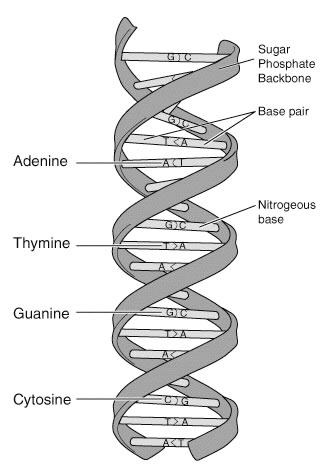DNA (deoxyribonucleic acid) contains the genetic instructions for all living things on Earth.
It is a nucleic acid - a large molecule made up of smaller molecules known as nucleotides.
DNA contains two types of nitrogenous bases (also known as nucleobases or nucleotide bases). These are the purines and the pyrimidines.
 Adenine and guanine are the purines in DNA. The pyrimidines are cytosine and thymine.
Adenine and guanine are the purines in DNA. The pyrimidines are cytosine and thymine.
When a nitrogen atom in a purine or a pyrimidine bonds with the carbon atom in deoxyribose - a type of sugar that contains five carbon atoms - it becomes a molecule known as a nucleoside.
When between one and three phosphate groups bond with a nucleoside, it becomes a nucleotide. The nucleotides in DNA are known as deoxyribonucleotides.
DNA is a polynucleotide, a long chain of nucleotides.
A macromolecule that is made up of smaller molecules that repeat over and over is known as a polymer. DNA is a type of polymer.
Some viruses are made up of single strands of DNA.
Double Helix
In 1953, James Watson, an American molecular biologist and Francis Crick, a British microbiologist, suggested that most DNA was in the form of a double helix - two three-dimensional curves that coil around each other.
Rosalind Franklin, a British biologist and X-ray crystallographer, had been studying X-ray diffraction patterns of isolated DNA fibers. She realized that two or more polynucleotide chains must be coiled around each other as helixes in order to produce a DNA macromolecule.
Looking at Franklin's work, Watson and Crick assumed that in DNA, two polynucleotide chains formed a double helix.
Base Pairs
As Watson and Crick studied the possible positions of the nucleotides, they realized that the DNA double helix could only be stable if adenine was always opposite thymine or if guanine was always opposite cytosine.
These complementary sets of nucleotides - adenine-thymine and guanine-cytosine - are known as base pairs.
The two nucleotides in a base pair are connected to each other, across the two DNA strands, by hydrogen bonds.